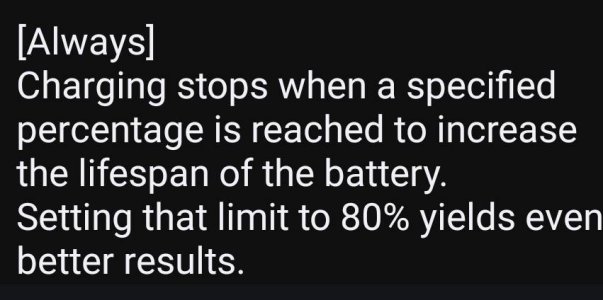pauldroidr2d2
Well-known member
- Jun 8, 2010
- 2,787
- 195
- 63
I have it. I'm using it too.So has anyone seen this setting yet?
I have it. I'm using it too.So has anyone seen this setting yet?
Awesome!!I have it. I'm using it too.
Verizon is my carrier. Locked.Awesome!!
Your carrier or unlocked version?
NiceVerizon is my carrier. Locked.
So far I'm liking it. It definitely charges faster. The phone doesn't seen to get as warm during charging either.

Can you point to the spec on this part, or something similar, I'm definitely curious about the circuit/algo design on this.I have, even before this type of feature was common and unplugging manually. Another life extending benefit not often mentioned is having this feature built in means you can basically treat the phone like a mains powered device. Once the battery hits 80% and stops charging, the phone runs strictly from the charger, reducing the amount of cycles (and thus cycle related degradation) it goes through. Great if you're a heavy user.
The latest beta removed it. I'm a little disappointed.Seems unlocked version on a Wait list
Ahh ..you were on Android betaThe latest beta removed it. I'm a little disappointed.
Beta, eh? Darn! Back to that crowded Google Waiting Room.The latest beta removed it. I'm a little disappointed.
Yes, I noticed the same thing. I wonder why they'd remove that feature. Weirdness.The latest beta removed it. I'm a little disappointed.
Hi I see a lot of different opinions out there. But I can tell you my experience. I use something called chargie. It is a device that goes in between the brick and the phone it connects to the phone by Bluetooth so you can control the settings via app. I have it set to limit my charge to 80 and the newest version charges at I think a max of 7watts. Which is plenty for overnight charging and if I need a rapid charge I just take it off. So I have an old pixel 3a that I now use as a security camera. It has always had a chargie on it since it was bought brand new. So always 80 percent charge. According to accubattery that battery is still holding 95 percent of it's capacity. So that phone is 6 years old and the battery has only degraded by 5 percent. It might be a little bit more I haven't checked it in a long time. Earlier this year my p6 pro broke and I had to use the old 3a for a few weeks while I got my 8 pro. The battery on my 3a lasted all day with moderate use. In my opinion that's a pretty good performance for a 6 year old phone. And that's why I only charge my phones to 80. Other people might have different experiences and that's fine I'm just telling you mine.I don't understand why anyone would use this.
Can you point to the spec on this part, or something similar, I'm definitely curious about the circuit/algo design on this.
If they're regulating it this cleanly (zero battery transition/draw while plugged in at say 80%), why not allow the same at say 95%?



Yep, this is what I figured was going on.And once I hit 80%, charging stops just like it would when it hits 100%. I can see that on Ampere. At this point, the charge rate drops to zero. Ampere sees that it's plugged in, but the charge current goes to nothing and stays there from then. Occasionally it'll drop to 79%, but that's it.
Yep, this is what I figured was going on.
It's still discharging/charging, steadily, just not charging it to 100%, so you're cycling 79-80-79-80... instead of 99-100-99-100...

Still in beta?Just as mysteriously as the feature left, it has returned.

